Croatia has opened its doors to digital nomads, and that’s great news for anyone wanting to live in this stunning country. I can certainly vouch for it, I loved my time in Croatia and would go back again tomorrow. But, as a digital nomad in Croatia, you’ll need to know the ins and outs to make your time in this beautiful destination go as smoothly as possible.
I found life in Croatia to be laid-back, full of beauty, and awash with great food. It’s also a very friendly place that’s full of countless things to see and do, as well as a huge amount of history to explore. With the establishment of a digital nomad visa, Croatia has seen more and more remote workers wanting to stay for longer, and I can totally understand why.
My experience was nothing but positive, and to make sure yours is the same, I’m going to cover some of the most important information you need to know in this post.
About Living in Croatia
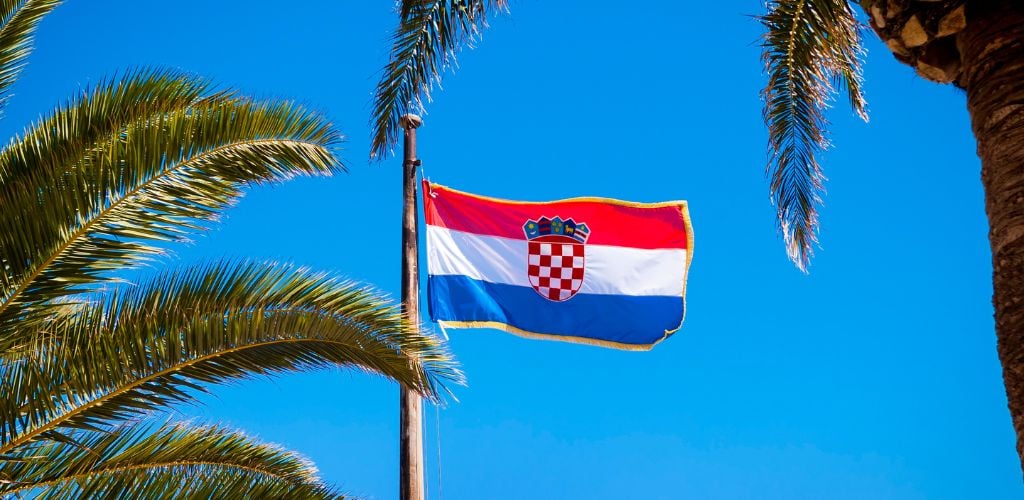
Croatia is a country located in the Balkans, bordered by Serbia, Bosnia & Herzegovina, Hungary, Slovenia, and Montenegro. It’s very easy to travel around the region, but inside the country itself, there’s a huge amount to experience. Working remotely in Croatia is made a lot easier thanks to the low cost of living and digital nomad visa.
Having gained independence in 1991, Croatia has grown as a country in terms of culture and tourism. Every area offers something new to experience, and the islands have that idyllic laid-back vibe that invites visitors from all over the world. For me, the islands were the most beautiful part of the country, but I also loved the fast-paced vibe in the capital, Zagreb, in contrast.
Croatia adopted the Euro in January 2023, officially becoming part of the Schengen zone. Despite that, the country has retained a lot of its authentic charm and to me, it never felt like an extension of Europe, it always felt like an entirely different region on its own. As a result, a long-term stay in Croatia really does tick all the travel experience boxes.
Living in Croatia as a Digital Nomad
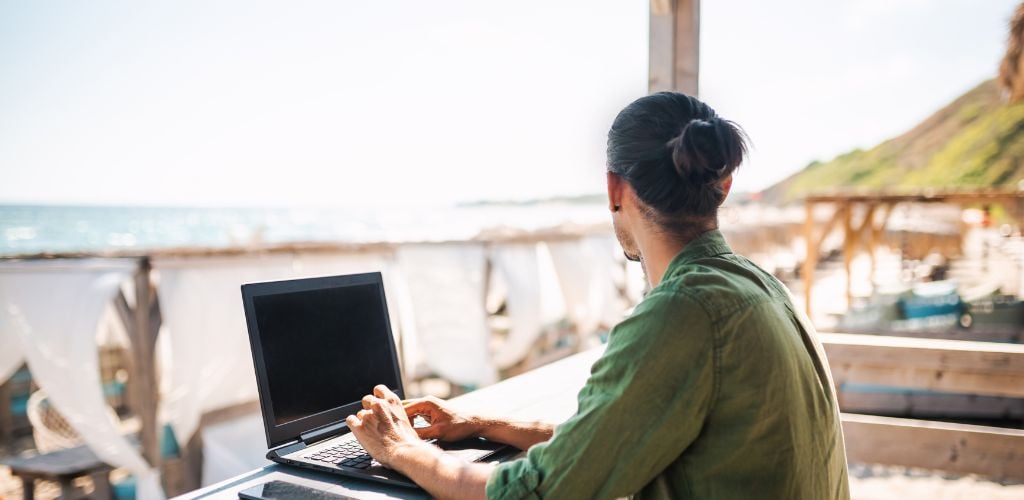
Living in Croatia as a digital nomad is an enriching experience. I’ve already mentioned that there’s now a digital nomad visa, which I’ll talk about in more detail a little later in this guide, but it certainly makes life a lot easier. Finding employment in Croatia as a foreign citizen can be extremely difficult, so the remote working route is particularly popular.
The co-working scene has grown over the last few years, and you’ll find some great cafes to work from across the country. However, the islands are a lot more laid-back, and I found simply sitting in a random beach cafe with my laptop to be the perfect choice on many occasions. There’s also a huge amount to see and do; there’s no shortage of activities to try in your downtime.
It’s not hard to meet new people in Croatia, so feeling lonely shouldn’t be a concern. There are many other remote workers in the country, especially in digital nomad hotspot areas, such as Zagreb, Split, and Dubrovnik. If you choose to stay in a hostel at the start of your visit, you’ll also meet plenty of like-minded people to befriend and network with.
The language barrier can be an issue occasionally, as it’s estimated that around 60% of the country speaks English to some degree. The key phrase there is “to some degree,” as locals aren’t often fluent. However, this is really only an issue in rural areas, and even then, you can make yourself understood with a little patience and effort.
Is Living in Croatia Safe?

Overall, Croatia is a safe country to visit, and I never felt unsafe at any point during my long-term stay. There’s a totally different vibe between the cities and the islands, and I would highly recommend that you visit several to give you the whole experience. Even then, you’re unlikely to experience anything that will make you wary or uncomfortable.
Of course, there are negative situations and bad people all over the world. It’s worthwhile remembering that common sense is your friend, so never walk around on your own at night in quiet areas, don’t leave your drinks unattended, don’t flash your valuables, and don’t be too trusting with people you’ve just met. Life as a digital nomad in Croatia is pretty free of any major concerns in terms of safety, but it pays to be on your guard regardless.
The only potential risk is pickpocketing, and even then, this mostly occurs in the capital city and isn’t a general rule across the country. Again, this isn’t unusual in a large city, so personally, I wouldn’t worry about safety when visiting Croatia.
Best Places to Live in Croatia
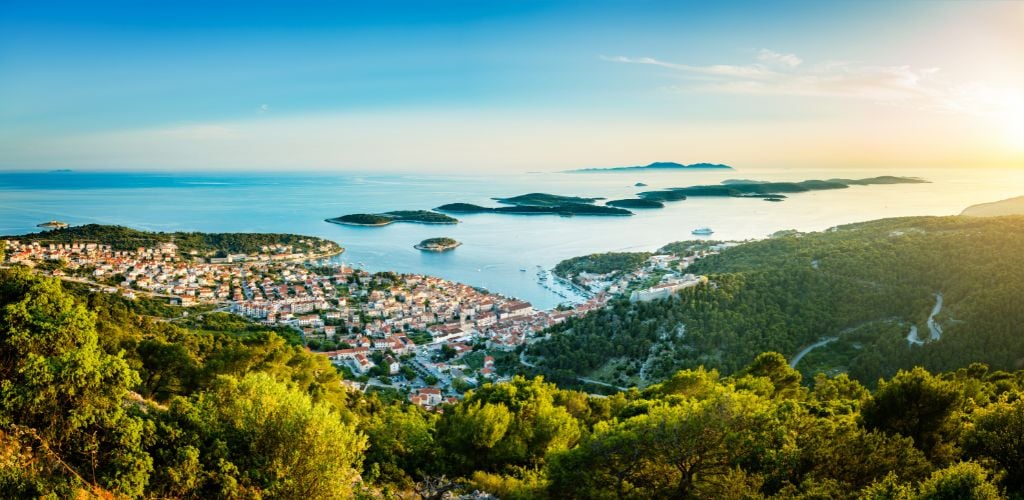
Being a digital nomad in Croatia means choosing the right place to base yourself; it can really make or break your visit to any country. I traveled around the country a fair amount during my time there, and I’ve come up with a few areas I think would best suit digital nomads overall.
1. Zagreb
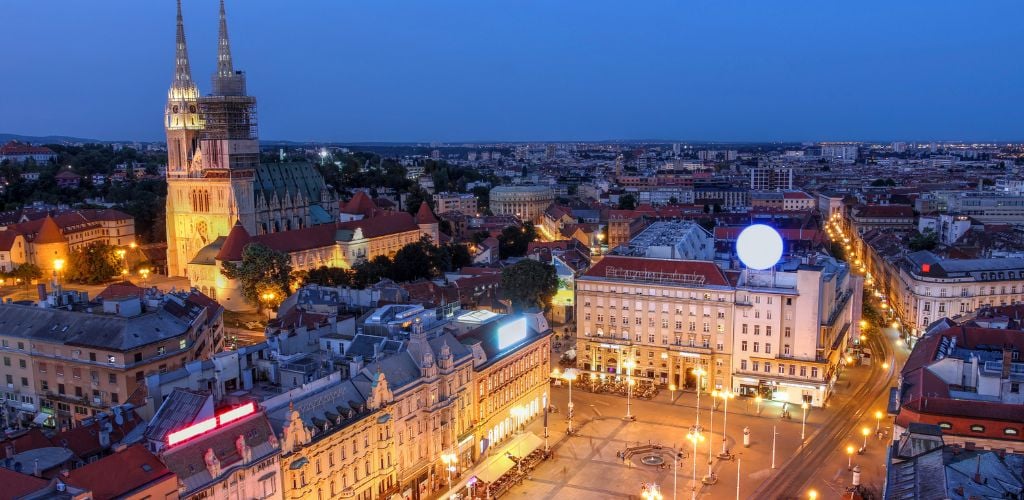
The capital city is a vibrant and action-packed place to be, so it makes sense that remote workers will find it a good spot to live. There are many co-working areas in Zagreb, and there’s a very lively pavement cafe scene, which is a good choice when it comes to finding a spot for work from. I loved the mixture of old and new in Zagreb, and while the cost of living is a little higher here compared to some other areas, the difference isn’t huge.
Zagreb’s lively nightlife is a great way to meet new people, and there’s a large number of accommodation choices, including Airbnbs, hostels, and shared accommodation. I also found that WiFi was pretty high quality across the city and was free in most cafes, without many outages or glitches.
For me, Zagreb has that cosmopolitan/European feel, but it still retains a lot of its authenticity. There are many museums and parks to explore, and while it’s located inland, it’s only around a 1.5-hour drive to the nearest beach. If you’re not the biggest fan of the tourism scene, Zagreb will give you a more traditional lifestyle, while still offering plenty of access to modern-day fun.
Best Areas to Live in Zagreb
Zagreb is a large city, and several spots are ideal for remote workers. If you want to be centrally located, Donji Grad is a good choice, although bear in mind that the cost of accommodation here is a little higher due to its proximity to nightlife, shopping, and attractions. I stayed in this area for a short while, and I appreciated how easy it was to get around; the public transport is high quality, and I never found it difficult to get to where I wanted to go.
Maksimir is a good piece of middle ground because it’s close enough to the city center and easy to get there (especially after a night out), but it’s far enough away to feel more suburban. The national soccer stadium is located here, so it can get quite busy when games are on. This is also where you’ll find a huge public park where I spent many sunny days sitting under a tree with my laptop – it was a surprisingly productive experience, and was definitely a change in scenery.
If you want a calm and tranquil spot close to the city then Šalata is an option, although the price of accommodation is higher here. It’s a pretty upmarket spot, and while it likely won’t be the first choice for most digital nomads, it could be a possibility if you want a higher standard of living.
Coworking Spaces in Zagreb

Zagreb is home to several great quality coworking spaces, but they’re not for everyone. I’m not the biggest fan of spaces such as this, as I prefer to work in a comfortable cafe. If that’s your vibe, you’ll find plenty of options, but if you do want to head to a coworking space, here are three that I think are worth checking out:
- Hub 385: I found Hub 385 to be the best coworking space in Zagreb and it offered a comfortable place for me to work for the day. I needed to do a few video calls and the internet was strong without any glitches. They also offer private offices and networking spaces.
- Impact Hub: Another popular coworking area in the center of Zagreb is Impact Hub, which offers affordable daily and weekly passes, with plenty of facilities on site. This is a good coworking space for those who want to network and collaborate.
- BIZKoshnica: This coworking space has two locations in the city center and offers membership packages for those who want to visit regularly. They also have regular meetups and events for members, so it’s a great way to meet other remote workers.
Things To Do in Zagreb
As the capital city, there is plenty to see and do in Zagreb. Here are some of my top picks:
- Day trip to Plitvice Lakes: One of the most beautiful places in the whole of Croatia is Plitvice Lakes National Park; your stay won’t be complete without heading here.
- Take a city walking tour: Zagreb is home to lots of hidden gems, and it’s easy to walk around and miss them. I took a short walking tour and I really enjoyed it; it gave me a totally different view of the city.
- Cathedral of Zagreb: One of the most important sights in the city is the cathedral, and it’s also one of the tallest buildings in the country. Beautiful both inside and out, it’s a must-visit.
- Museum of Broken Relationships: Okay, so it might sound depressing, but it’s a really interesting place to visit – I spent a lot more time here than I imagined I would.
- Nikola Tesla Technical Museum: Tesla is one of the country’s famous sons, and this museum is a homage to his work. It’s a fascinating spot and is absolutely worth a half-day visit.
2. Dubrovnik
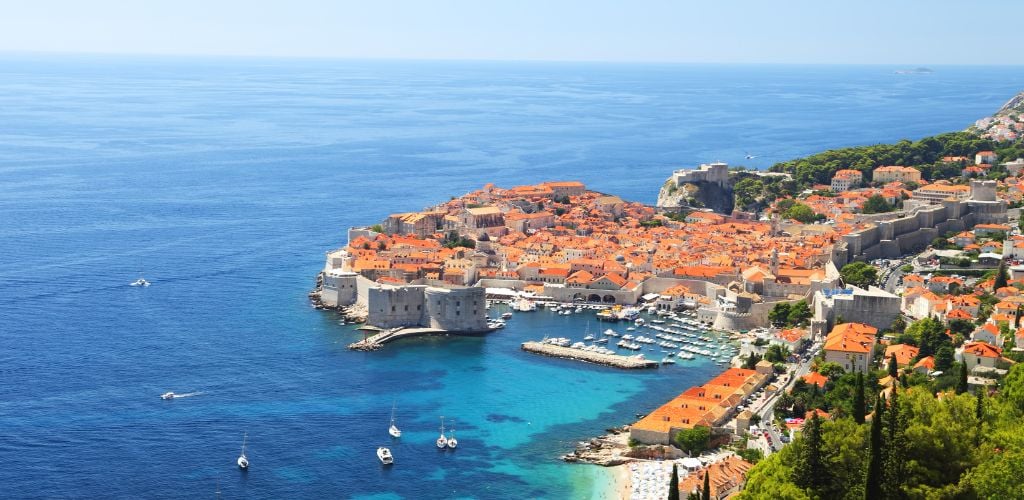
Dubrovnik is one of the most famous tourist areas of Croatia, and it’s packed during the summer months with visitors trying to walk along its famous walls. It’s also home to some top filming spots from the Game of Thrones, which definitely adds to its appeal. However, it’s also a great area for digital nomads, thanks to the wide range of things to see and do, great quality internet, and plentiful work-friendly hostels and cafes.
It’s a good idea to visit Dubrovnik outside of the main summer months if possible, as you may find it a little overwhelming during July and August in particular. However, during the shoulder months and in the winter, it’s a wonderful place to stay, and while some things may be closed, such as bars and restaurants, there’s still enough going on to keep you occupied.
The vibe is pretty lively in Dubrovnik, and it’s easy to meet other remote workers and travelers. There are also plenty of accommodation options in the form of Airbnbs and hostels, although prices are higher during the summer months.
Best Areas to Live in Dubrovnik
Dubrovnik isn’t as large as Zagreb, but it’s still sizable, with a few locations that are ideal for digital nomads. The Old Town is the center of the city and the main tourist area, with quite a few Airbnbs and hostels available. But as mentioned, they’re more expensive during the summer months, and you may find that many close during the winter. Despite that, being so close to the action has its perks, and you’ll rarely need to use public transport.
If you do want to stay slightly out of the way, Ploče is just a stone’s throw from the Old Town but it’s a lot quieter. In this area, you’ll find Banje Beach, where I spent endless hours, and lots of upmarket cafes. This area tends to have a lot of classy hotels but there are also lots of Airbnbs – you may be able to negotiate on the price if you’re lucky.
Another option is Lapad. This is a more residential area close to the beach that has some great spots for walking. It’s also a lot cheaper than the center of town, and is connected to all the main attractions in the city by bus. I liked Lapad because it was possible to dip in and out of the tourist scene whenever I felt the need.
Coworking Spaces in Dubrovnik

Dubrovnik is mostly a tourist destination, and while it’s certainly opening up to long-stay visitors such as digital nomads, it’s yet to catch up in terms of coworking spaces. That being said, I still found plenty of great work-friendly cafes, such as Coffee Break, and one of my ultimate favorites—Cafe Festival.
Most hostels also have work areas you can take advantage of, but I found working in my apartment to be preferable. It meant that I could escape the noise and get my work done, before heading out when I’d finished to enjoy everything Dubrovnik has to offer.
Things To Do in Dubrovnik
There’s no shortage of things to do in Dubrovnik. I often found it hard to focus on work instead of heading out to sightsee! Here are some of my top picks:
- Game of Thrones Walking Tour: If you’re a GoT fan, this walking tour is the ultimate way to spend a few hours. You’ll get to see all the main filming spots and take plenty of photos along the way.
- Dubrovnik City Walls: This is the number one attraction and the main reason most people visit Dubrovnik. It’s a good idea to get there early to avoid the crowds, or to visit in the shoulder months/winter if possible.
- Dubrovnik Cable Car: If you want the very best view over the city (and you should), the cable car is the way to get it. Note that the cable car is only open during the summer months.
- Fort Loverijnac: This ancient fort has stunning views, and you can also learn about the interesting history of the area. The sunset from here is epic.
- Banje Beach: This is the closest beach to the center of Dubrovnik and a great spot to chill out and enjoy the sun in the hottest months.
3. Split
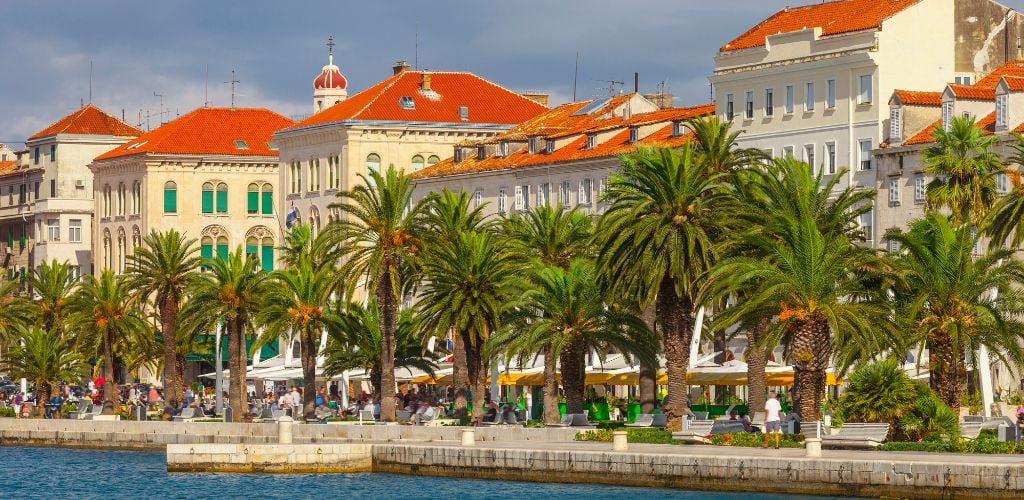
Split is one of the most popular and lively parts of Croatia, and during the summer months, the vibe is fun with a capital F. However, that doesn’t mean it’s not possible to find a quiet spot – one of my favorite things about this area was the chance it offered to dip in and out of the noise. Split is also a digital nomad hotspot these days, and when you see the beaches, you’ll understand why.
Life in Croatia in general is pretty slow, and even though Split is touristic, it’s still pretty laid-back. There’s a lot of history in this region and the natural landscapes are off the scale. Oh, and don’t get me started on the food; the Dalmatian region is home to some of the freshest and most delicious produce in the country.
I think Split is one of the best areas in Croatia for remote workers because it offers a little bit of everything. It’s also home to many great quality coworking spots and a myriad of cafes to sit and watch the world go by as you do some work. The nightlife scene is lively, but you can also escape the noise and find solace in nature if you choose.
Best Areas to Live in Split
Split is a pretty large city, so there are plenty of different areas to choose from when it comes to choosing where to stay. The Bacvice area was my favorite because it’s a beachfront area, there is great nightlife, but you can also head back from the main streets and find an authentic way of life. Alternatively, Veli Varos is another great choice, which is close to the town center but has a more ‘away-from-it-all’ vibe.
Poljud is another top spot, and it’s ideal for digital nomads who want to cut costs by staying away from the main tourist center, but who also don’t want to be too far away. Accommodation here is a little cheaper, and there are plenty of markets to buy local produce so you can cook at home.
I spent a good amount of time in Stobreč, and I really enjoyed the less crowded beaches and the ability to walk around freely. There are some good Airbnb choices in this area, and you may be able to negotiate the price if you want to stay for longer.
Coworking Spaces in Split

Split’s rising digital nomad scene means plenty of coworking spaces have opened their doors, and I used several of them during my time there. Here are some of my favorites:
- Tink Tank: This is a really collaborative space that has the feel of an upmarket hostel. There are cooking facilities on site, and the open-plan design encourages everyone to network and talk.
- Scale Up Office: This is one of the newer coworking spaces in Split and offers some great prices on daily, weekly, and monthly passes.
- Smartspace: If you want to work right in the middle of the Old Town, this coworking space is for you. It also offers hourly passes, which is useful if you just need to do a quick piece of work or make a video call.
Things To Do in Split
Split has plenty to see and do; you’ll be spoiled for choice of ways to fill your free time. Let’s check out some of my top picks:
- Diocletian’s Palace: This huge UNESCO World Heritage Site is a living, breathing part of the city which provides a fascinating glimpse into history.
- Marjan Hill: I loved climbing the stairs to the top of this hill and snapping some photos to share with my friends. However, if you want peace and quiet, go early or later in the day to beach the crowds.
- Bačvice Beach: This is my favorite beach in Split simply because it’s so easy to get to. If you finish work early, wander down, grab a sun lounger, and soak up those rays.
- Krka National Park: Just an hour’s drive away from Split, you’ll find one of the most amazing natural parks in Europe. The waterfalls here took my breath away.
- A boat trip to the Blue Cave: The coastline around Split is packed with great diving sites and areas of importance, but the Blue Cave is without a doubt, one of the most eye-opening.
4. Zadar
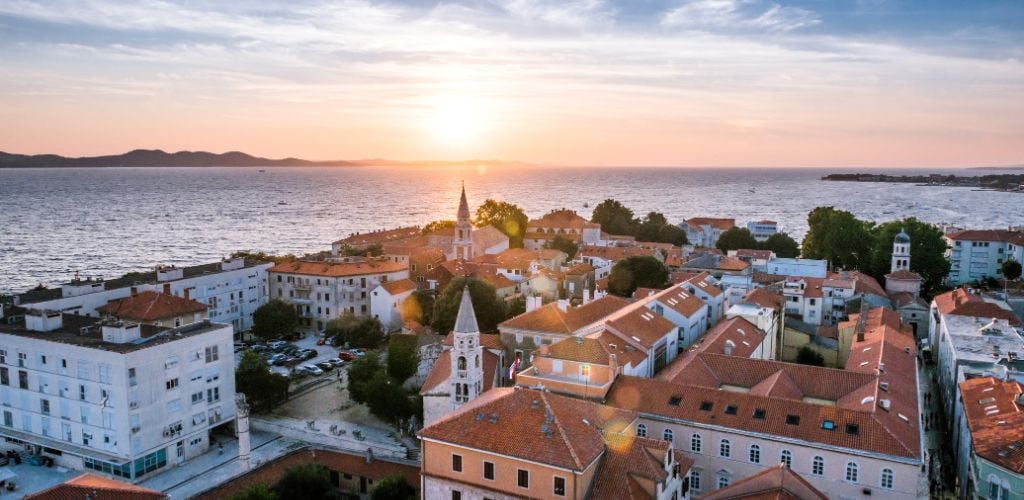
On the Dalmatian coastline, you’ll find the beautiful city of Zadar, a very popular destination during the summer months. As with many of Croatia’s cities, it’s become somewhat of a hub for digital nomads and its remote work scene is growing month by month. While Zadar is touristic, meaning that much of it does close down during the winter months, it offers a laid-back and authentic spot to stay while getting your work done.
I spent a month in Zadar, and I liked the blend of tourism and local life. It reminded me of Split in some ways, although a little smaller and less frenetic. There are also some beautiful beaches around this area, and the Old Town is a great place to explore on a day off.
There are a few coworking spaces in Zadar, and I found the internet in this city in particular to be really fast, without any outages. It’s also a great place to meet new people, and you can find some affordable Airbnb rentals if you head slightly away from the Old Town area and into the more suburban reaches. You might also be lucky enough to find co-living spaces, which are certainly growing in popularity.
Best Areas to Live in Zadar
Zadar’s Old Town is a popular place to stay, although it’s the most expensive part of the city because it’s also where most of the attractions are. However, if you want to be central and you don’t like the idea of traveling back and forth, it’s a better choice. There are also some good coworking spots in this part of the city and the internet is reliable.
The Borik area is also a good choice, particularly for anyone who loves beaches. You can easily venture down to the sea when you’ve finished work for the day, and there are many Airbnb options around here. In addition, there are some great local restaurants if you head back from the main tourist streets.
Another choice is Diklo, which is a lot more authentic than the first two choices and it’s where I chose to stay while I was in Zadar. There are many rentals around this area, as well as Airbnbs, and the cost of renting is a little lower than in the central parts of the city. This is another waterfront location and the laid-back feel to the area offers a more homely feel.
Coworking Spaces in Zadar

Zadar’s growing coworking scene is still developing, but there are two very notable choices:
- COIN Coworking: In the heart of Zadar you’ll find one of the newest and most popular coworking spaces: COIN. This is an affordable and collaborative space where you can meet and network with countless other digital nomads, or simply get your head down, and get your work done.
- Code Hub Zadar: Code Hub has offices in several Balkan countries and is growing in popularity. It offers reasonable membership packages and also has large rooms for collaboration.
Things To Do in Zadar
- Visit the Kornati Archipelago: A visit to the stunning Kornati Islands is a great option for a day off, especially when you encompass Telašćica Nature Park too.
- Sea Organ: Located in the Old Town you’ll find the famous Sea Organ, where sea energy creates music. This is a very popular spot and is often crowded during the summer months.
- Kayaking on the Zrmanja River: If you’re feeling the need for some adrenalin pumping through your veins, a kayaking day trip on the beautiful Zrmanja River is the ideal day off activity.
- Roman Forum: These well-preserved ruins are located in the Old Town, which dates back to the 3rd century.
- Cathedral of St. Anastasia: This is the largest church in the area and is beautiful both inside and out. The church dates back to the 12th & 13th centuries.
5. Hvar
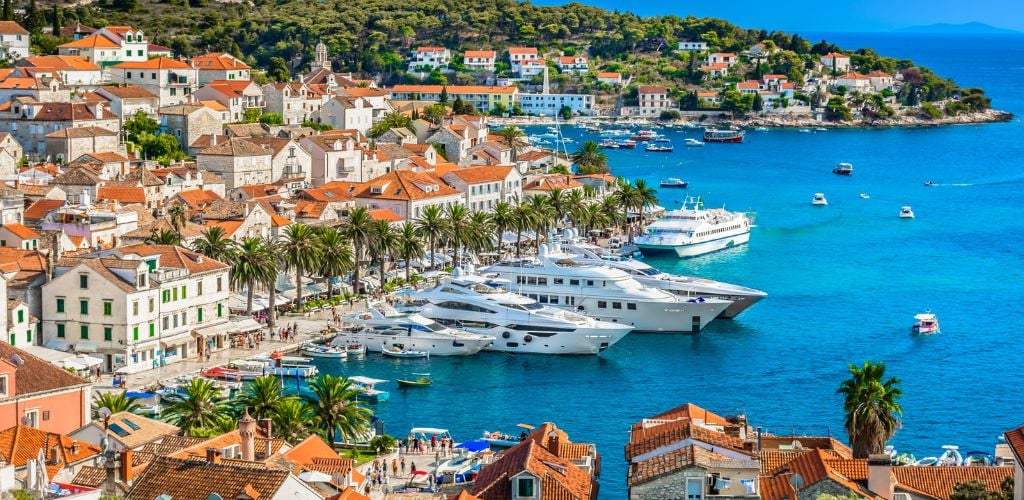
Up to now, I’ve focused on mainland Croatia, but Hvar is an increasingly popular choice too. I found Hvar to be a great blend of liveliness and peace. Hvar Town itself is known for its vibrant nightlife, and you can easily dip in and out of that as you want to, but if you venture just slightly away from the noise, you’ll find a more authentic and laid-back vibe that’s perfect for enjoying your days in the sun.
You can easily head over to Split or Dubrovnik via the ferry network, and there are countless other small islands around that you can sail to on your day off. I think Hvar is a great place to find inspiration; the scenery is like nowhere else and you can choose to be around people or to head off on your own. It’s a good place to reset, without being submerged in a rural area.
As a digital nomad in Croatia, an online connection is important. The internet on Hvar is good; it’s not excellent, but it’s good. To get around the WiFi issue I turned my phone into a hotspot, and I found that worked better, although it did eat through my data. However, there are some great cafes you can use, and accommodation isn’t lacking either.
Best Areas to Live in Hvar
Hvar is the fourth largest island in the entire Adriatic, so there are plenty of neighborhoods to check out. Without a doubt, the liveliest place to stay, and probably the easiest, is Hvar Town. This is where you’ll find all the main nightlife, restaurants, and cafes, as well as historical sights and great beaches.
However, it’s not the only place to consider. I stayed in Jesla which was a great spot for chilling out and completing plenty of work by the sea. It’s conveniently easy to get over to Hvar Town from Jesla, with a surprisingly good bus network in place. I also found cheaper Airbnbs in this area, compared to the capital of the island.
If you want to be around history, Stari Grad is a good option. Head to the top of Glavica Hill and you’ll know exactly why it’s a great place to stay—the views are stunning. Accommodation here isn’t as plentiful as it is in the capital, but you’ll certainly find some rental options and probably at a cheaper price.
Coworking Spaces in Hvar

Hvar’s coworking scene is likely to grow over the coming months and years, as the digital nomad population increases, but there aren’t any top-quality coworking spaces on the island currently.
I spoke to some remote workers who said if they needed to use a coworking space, they’d jump on the ferry over to Split and use the facilities there, but overall, most people work from their accommodation, the beach, or from the many cafes around the island.
Things To Do in Hvar
The vibe in Hvar is mostly about beach time during the day and, if you choose, partying at night, but that doesn’t mean there’s nothing else to see and do. For me, it was about relaxation, but here are some notable things to add to your list:
- Visit the Pakleni Islands: There are some stunning islands around Hvar, and the Pakleni Islands fall into that category. A boat trip is the ideal activity for a day off, and believe me when I say you’ll come back feeling refreshed.
- Fortica Fortress: Dating back to when Hvar was under Venetian power, this fortress is an imposing sight, and the views from the walls are stunning.
- Strand Mekićevica: This was one of my favorite beaches, and I’d go back again tomorrow. The waters are clear, calm, and ideal for swimming, with plenty of facilities, such as beachside cafes.
- Luviji Winery: I love wine, so a visit to a local winery is always on my list. This family-run establishment is a Hvar staple and you can tour the building and taste plenty of glasses—on your day off, of course!
- Explore Stari Grad: This is one of Europe’s oldest towns, and it’s literally like an open-air museum. The views over the sea are also pretty epic as the sun is setting.
How to Find Accommodation in Croatia
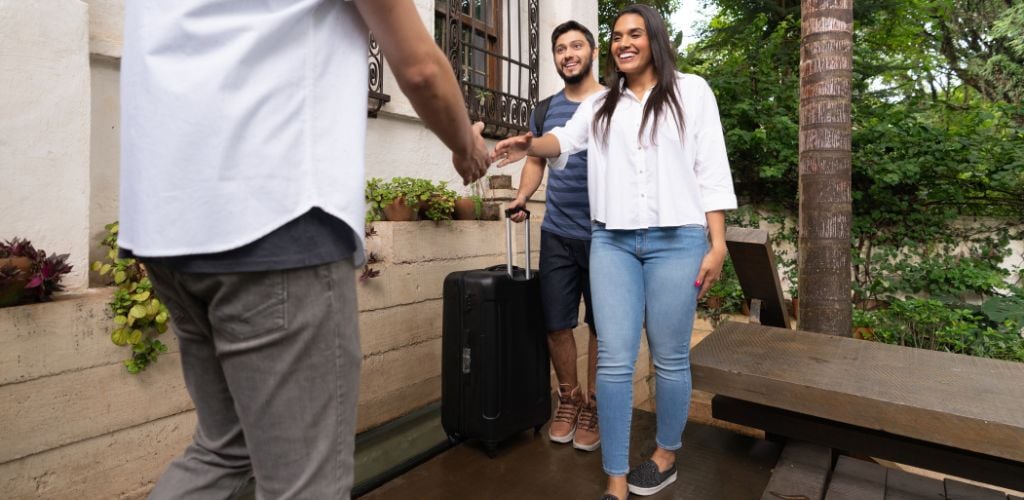
Accommodation options for digital nomads living in Croatia are plentiful, but finding somewhere can be tricky if you leave it until the last minute. I stayed in Airbnbs for most of my stay because I wanted to move around, but you can find an apartment to rent if you’re willing to put in the leg work.
Here are some of the best ways you can find accommodation:
1. Airbnb: I noticed that Airbnb is very present in Croatia; more so than in some of the other countries I’ve visited. It’s an ideal way to browse plenty of options for good prices.
2. Booking.com: While staying in a hostel or hotel might not be your ideal option over the long term, booking.com is a safe choice for when you first arrive.
3. Coliving: Since the establishment of the digital nomad visa, co-living has become popular. This is a good way to save cash and get to know other remote workers.
4. Facebook groups: There are many digital nomad groups related to Croatia in particular, and these are excellent when looking for adverts and asking for advice.
Cost of Living in Croatia
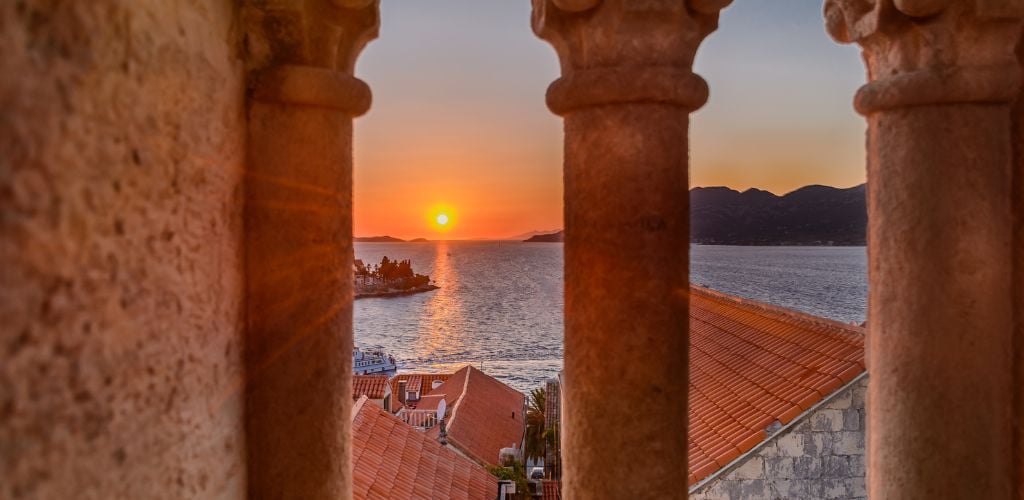
The cost of living in Croatia has increased a little over the last few years, but that is a common theme across Europe since the pandemic. I certainly found Croatia to be cheaper than Italy, which is located over the Adriatic. So, generally speaking, most digital nomads can live in Croatia comfortably for a lower cost.
Restaurants and Groceries

The best advice I can give here is to eat at home. Learning to cook traditional food will not only teach you a new skill but you’ll save so much money. Tourist restaurants charge inflated prices, especially if you’re in Dubrovnik. However, if you head to fresh fruit and vegetable markets and supermarkets you’ll save a lot of cash.
To give you an idea of costs, you can purchase a coffee for around €3 ($3.50) and a takeaway pizza from a chain restaurant for around €8 ($8.80). You can head to a local market and purchase a week’s worth of fresh fruit and vegetables for roughly €30 ($33), and a packet of fresh chicken breasts will cost around €5 ($5.50). In comparison, one meal out at a restaurant will cost around €30 ($33) depending on what you have.
Accommodation Costs

I found the largest cost to be accommodation and naturally, this has increased in the last couple of years too. Many digital nomads choose to go down the coliving route to save cash – it’s a great option and you may even end up making lifelong friends this way too. If you choose to rent, you can expect to pay around €420 ($460) with utilities on top.
Your electricity and water costs depend upon what you use, but in summer, you’ll most likely want to use air-conditioning. In that case, you can expect to pay around €100 ($110) all in.
If you choose to live somewhere like Dubrovnik in the height of summer, you can expect to pay more. The shoulder months and winter time are much cheaper in the traditional tourist areas.
Transportation Costs in Croatia
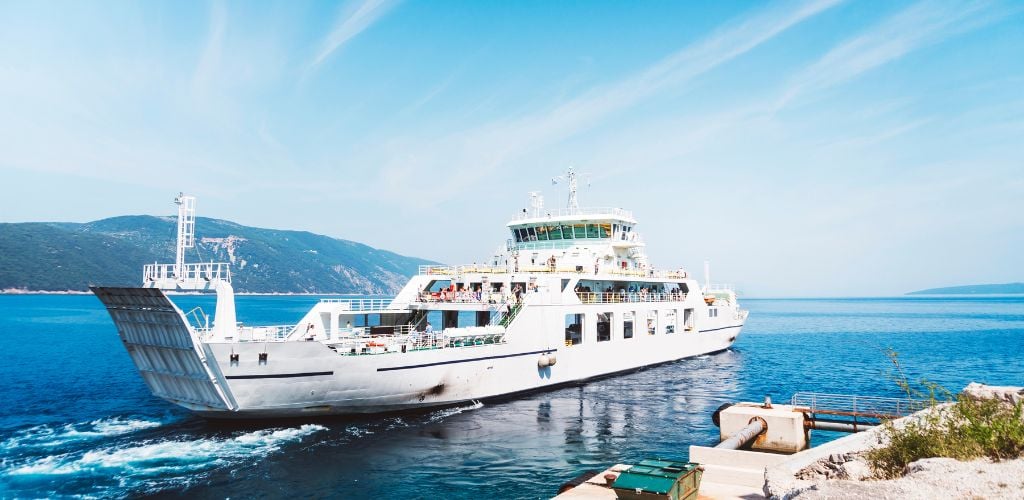
Working remotely in Croatia means you’re probably going to want to move around a little and see as much as possible; I know I did. The biggest frustration for me was the public transport network around the country, as it’s not super-reliable and does tend to take a chunk of time to get from A to B. However, the ferry network is consistently good.
Price-wise, you can expect to pay around €2-€4 ($2.20-$4.40) per one-way journey on the bus if you’re traveling locally. Long-distance buses vary in price depending on where you go and what time you choose. Ferry prices also vary depending upon the time of year, but you can usually get a ticket for around €8 ($9) one way.
I avoided taxis or Ubers unless I had no other option. They’re pretty expensive and most of the time you can use the local public transport network for a lot less. That being said, if you’re traveling alone at night, I recommend going down the private taxi route for safety reasons.
SIM Cards and Data

As you’ll be spending a longer amount of time in Croatia, I’d recommend you get a SIM card and top it up monthly. I used T-Mobile, and I didn’t notice any black spots or problems. You can purchase a SIM at a T-Mobile store (they’re everywhere) with your passport. It’s a quick and easy process, thankfully!
Telemach, A1, and Tomato also offer SIM cards which are ideal for digital nomads. You can purchase these from most large supermarkets, newsstands, and post offices. You simply install the SIM, follow the on-screen instructions, and then top up your card when you run out of data.
The other option is an eSIM which is good if you just want data and you’re not bothered about call time. Airalo is a quality choice in Croatia with good network coverage and many pricing options.
Money Saving Tips for Living in Croatia

Keeping cash in your pocket is important, especially when the cost of living in Croatia has increased. I found a few handy ways to save money, so let me share them with you now:
- Cook at home: I mentioned this earlier, but it’s such a great money-saving tip. You’re going to save a lot of money by not eating out all the time, and you’ll learn a new skill. I enlisted the help of a neighbor to show me how to cook Croatian food!
- Use public transport, and taxis sparingly: If you need to use a taxi because it’s late at night, do it, but overall, avoid them because they’re super-expensive. Compared to buses, you’ll save so much money; don’t be afraid to use public transport. It’s slow sometimes, but the frustration is easy to get over when you’re saving cash.
- Avoid using hotels and hostels too much: When you first arrive, it’s normal to book into a hostel or hotel while you find long-term accommodation but don’t let this become a habit. These cost a lot more than coliving, finding an apartment to rent, or an affordable Airbnb. It’s surprising how much the price adds up.
- Travel outside the main summer months: Croatia’s major towns and cities are mostly touristic, so you’ll always find prices are higher between May and October. If you can, travel outside of these times and you’ll notice much lower prices.
- Book long-distance bus tickets early: If you want to travel around the country, book your bus tickets online as far in advance as you can. You’ll get a better price, and you’ll be super-organized.
Coworking Spaces in Croatia and WiFi Speed

I mentioned some good coworking spaces in different areas, so I won’t go over them again, but overall, Croatia’s coworking scene is growing. I expect it to develop even more over the coming years, as more and more digital nomads choose the DN visa option and spend longer in the country.
So, let’s talk about WiFi speed. Croatia’s WiFi isn’t the fastest in the world, and it’s not the most reliable, but it isn’t the worst BY FAR. I never had any major issues; sometimes it cut out for maybe a few minutes, but it was back on very quickly. The main towns and cities have much better connection speeds than the rural areas and the islands.
Overall, Croatia’s average download speed is 62.16 Mbps, and upload average speed is 26.24 Mbps, according to Speedtest. From that data, Croatia is ranked 23rd in the world for Internet speed.
Activities and Things To Do in Croatia
I talked about some of the main activities and things to do in the individual city sections, but what other hidden gems should you add to your list during your time being a digital nomad in Croatia? Here are some of my recommendations.
1. Visit Rovinj

I really enjoyed the outdoor vibe in Rovinj, and it’s a great place to go if you want to get away from it all for a few hours or days. The town is located in Istria, an area famous for its delicious local produce. There are several great hiking routes around Rovinj, which will take you high up to see the coastline from above, as well as cycling routes.
Definitely check out Lim Bay as well as Mulini Beach, which are both ideal for days soaking up the sun and swimming. However, my favorite thing was to walk along the waterfront marina and enjoy people-watching with a coffee in hand. It’s a really chilled-out place, while still having enough nightlife and gastronomical options to keep you occupied.
2. Paklenica National Park
Most people focus on Krka National Park and Plitvice Lakes, and while those are definite must-visits, don’t forget about Paklenica National Park. The dramatic rock faces here look like something out of the American Wild West or Jurassic Park, with scenery to take your breath away. I’d highly recommend booking your tickets online to avoid queues in the summer months.
The park is located around 45 minutes away from Zadar by bus, or you could rent a car and drive at your leisure. You’re very likely to encounter traffic during the summer, so it’s a good idea to set off early.
3. Visit Pula Arena

Pula Arena is a huge Roman amphitheater in Pula, and it reminded me of the Colosseum. It’s very well preserved and walking around for an hour or so is a great way to spend your time. Pula itself is a wonderful place to visit, with lots of history and amazing food to try.
Located in Istria, it’s very easy to get to Pula from most large towns and cities. It’s around a three-hour drive from Zagreb and four hours from Zadar. Most bus companies offer a service so you can chill out while you travel, or you can rent a car.
The beaches around Istria are also very special, so remember to pack your swimming gear.
4. Go diving
Beneath the clear waters of the Adriatic, you’ll find an array of colorful and unusual marine life, so diving is a great way to spend your time. I went swimming in Bol, (not even diving), and saw dolphins! However, Lokrum Island is a great choice if you’re staying in Dubrovnik. Just ten minutes away, you can dive beneath and see countless fish and other marine species.
The Pakleni Islands are known for their diverse underwater nature, with Mali Lošinj another notable addition. The list goes on, and thanks to Croatia’s huge coastline expanse, you won’t struggle to find a dive site to suit your needs, beginner or otherwise.
Weather in Croatia
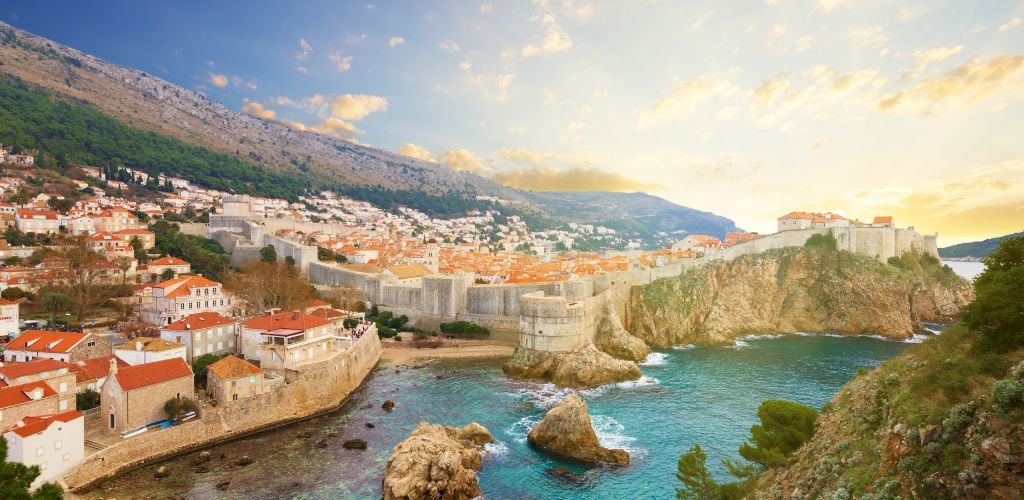
Life in Croatia is pretty much dictated by the seasons. Croatia’s main towns and cities are, as I’ve mentioned, very tourist-focused, which means during the winter, many things close down. However, that also means the heat subsides and the crowds dissipate.
I enjoy the shoulder seasons best, with May being my favorite month. For example, Dubrovnik experiences an average high of 21°C/70°F in May, which is ideal for exploring those city walls. Overall, Croatia has a Mediterranean climate, with warm summers and mild winters, unless you venture far inland, toward Plitvice Lakes, where it’s very normal for snow to fall during the winter.
The good thing is that although the summers are hot, they’re not stifling like some other countries. Split experiences an average high of around 30°C/86°F in the hottest month of July, and the temperature down the coastline is similar, give or take a few degrees.
Between December and the end of March, Croatia experiences generally mild winters. It’s hard to pull together the entire country into an average, but the popular digital nomad areas, such as Zadar, tend to experience an average temperature of around 7°C/45°F. Zagreb is slightly different as the winters are much colder, with an average low of around 0°C/32°F in January, and possible snow.
Pros and Cons of Living in Croatia

As with anywhere in the world, there are both pros and cons of being a digital nomad in Croatia. Here are the advantages and disadvantages to consider:
Pros of Living in Croatia
- Great weather: By now, you know that Croatia experiences wonderfully warm summers and mild winters in general. As far as exploring goes, it’s the ideal type of climate.
- Friendly locals: Croatia has some of the friendliest people I’ve ever met, and it allowed me to enjoy my time so much more.
- Plenty to see and do: You won’t be bored for a second; I never was. There’s so much to see and do across the country, from natural sights to history, gastronomy to nightlife.
- Amazing beaches: Croatia’s beaches are blindingly beautiful. Most have calm waters, which are ideal for swimming, and although they can be busy in the summer, it’s always possible to find a sheltered spot.
- Fantastic culture: Croatia’s culture is rich and vibrant; local people will be happy to share it with you—all you need to do is ask!
Cons of Living in Croatia
- Possible language barrier: You shouldn’t encounter too much of a problem in the major towns and cities, however, if you head into a rural area or perhaps into the lesser-known islands, it will be helpful to know a few words in Croatian.
- Red tape: A major frustration for me was that everything I tried to do required endless amounts of paperwork, waiting, or general red tape. It seems to be a nuisance across the board if you talk to other digital nomads, but it’s still annoying.
- Accommodation issues: In the height of summer, it can be hard to find suitable and affordable accommodation without a time-consuming search.
- Higher prices in summer: From June to September you’ll almost certainly find that most prices rise, especially for accommodation. As most people want to spend the summer months in the sun, it’s a challenge if you want to save cash.
Digital Nomad Visa for Living in Croatia

Good news is coming your way. Living in Croatia as a digital nomad is now easier than it’s ever been thanks to the relatively new digital nomad visa that came into effect in January 2021. This visa allows digital nomads to live and work in the country for one year, however, there’s currently no option to extend at the end of the 12 months.
To be accepted, you need to work for a company or own a company (that isn’t Croatian), and you’ll need to show that you have sufficient finances in your bank. You’ll also need an address, but you can simply use the address of your hotel or hostel when applying and then update your address when you find somewhere more suitable for the long term.
Click here for more information and a list of the full requirements.
In Conclusion
Croatia is such a special country, the idea of staying there long term should certainly fill you with excitement. I loved my time there, and I intend to return sometime soon. Now you’ve read this digital nomad guide to living in Croatia, I hope that you’re starting to formulate your own plans.
The new digital nomad visa has made things easier than ever before. With so many other remote workers in the country, it’s a place that offers such a great opportunity to work, have some fun, meet people, and explore a new culture. Oh, and don’t forget the food.
The post Digital Nomad Guide to Living in Croatia appeared first on Goats On The Road.





Recent Comments